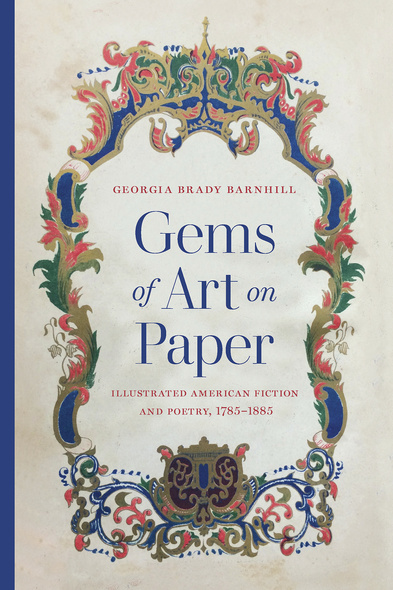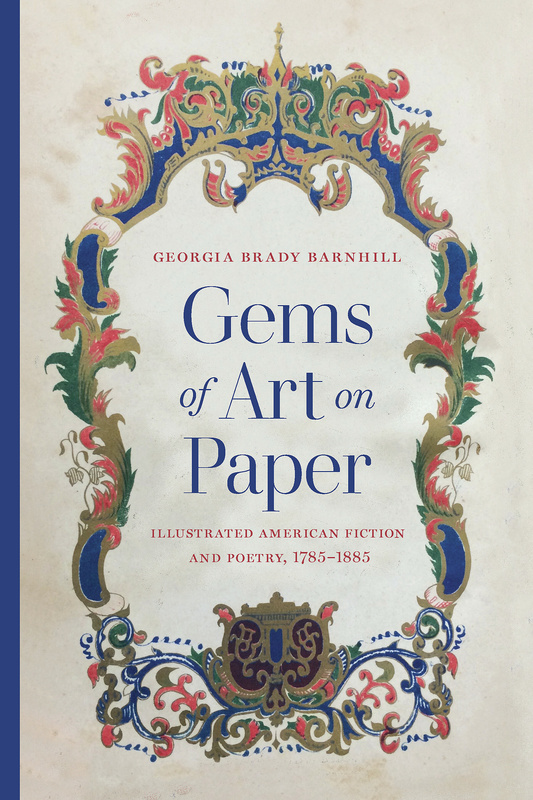
288 pages, 6 x 9
76 b&w illus.
Paperback
Release Date:21 Dec 2021
ISBN:9781625346216
Hardcover
Release Date:21 Dec 2021
ISBN:9781625346209
Gems of Art on Paper
Illustrated American Fiction and Poetry, 1785–1885
University of Massachusetts Press
Winner of the 2022 Ewell L. Newman Book Award from the American Historical Print Collectors Society
In the immediate aftermath of the Revolutionary War, only the wealthiest Americans could afford to enjoy illustrated books and prints. But, by the end of the next century, it was commonplace for publishers to load their books with reproductions of fine art and beautiful new commissions from amateur and professional artists.
Georgia Brady Barnhill, an expert on the visual culture of this period, explains the costs and risks that publishers faced as they brought about the transition from a sparse visual culture to a rich one. Establishing new practices and investing in new technologies to enhance works of fiction and poetry, bookmakers worked closely with skilled draftsmen, engravers, and printers to reach an increasingly literate and discriminating American middle class. Barnhill argues that while scholars have largely overlooked the efforts of early American illustrators, the works of art that they produced impacted readers' understandings of the texts they encountered, and greatly enriched the nation's cultural life.
In the immediate aftermath of the Revolutionary War, only the wealthiest Americans could afford to enjoy illustrated books and prints. But, by the end of the next century, it was commonplace for publishers to load their books with reproductions of fine art and beautiful new commissions from amateur and professional artists.
Georgia Brady Barnhill, an expert on the visual culture of this period, explains the costs and risks that publishers faced as they brought about the transition from a sparse visual culture to a rich one. Establishing new practices and investing in new technologies to enhance works of fiction and poetry, bookmakers worked closely with skilled draftsmen, engravers, and printers to reach an increasingly literate and discriminating American middle class. Barnhill argues that while scholars have largely overlooked the efforts of early American illustrators, the works of art that they produced impacted readers' understandings of the texts they encountered, and greatly enriched the nation's cultural life.
‘The fruits of much laborious archival work are gathered here. Some of the lengths to which the quest for knowledge has led the author are astonishing.’—Michael Leja, Imprint
‘Gems of Art [on Paper] is a thought-provoking read for scholars of nineteenth-century cultural productions of all kinds, and it will be referenced for years to come.’—Amy L. Sopcak-Joseph, Early American Literature
‘[E]ssential reading for anyone trying to develop a serious understanding of the history of the book in America.’—Tess Goodman, The Papers of the Bibliographical Society of America
‘Barnhill shares her vast knowledge, acquired over decades of working with these books and their illustrations as a curator at the American Antiquarian Society, in a readable and documentary manner.’—Kerry Carso, H-Material-Culture
‘Barnhill succeeds in challenging this hierarchy with a sparkling narrative filled with facts and figures, uncovering stories that have been previously ignored or unknown . . . The book is a page-turner as well as a reference source, which fills a yawning gap in the history of American art and literature.’—Julie Mellby, Panorama: Journal of the Association of Historians of American Art
‘Barnhill has deep knowledge of book history, having served as a curator at the American Antiquarian Society for more than four decades . . . The book is extremely readable and does not assume prior knowledge. Highly Recommended.’—CHOICE
‘From woodcut relief prints to copper- and steel-plate engravings, from lithographs to mezzotints to chromolithographs, Barnhill traces why and how readers came to visualize US literature in the nineteenth century. This is a book that will remain an enduring reference for scholars of American literature and culture for decades to come.’—Gordon Fraser, American Literary History
‘Barnhill does an excellent job tracing the slow development of publishing in the United States, from the late eighteenth century when there was a dearth of paper, ink, presses, and trained printers, as well as artists, to the late nineteenth century when all were available in abundance and American publications could compete with those of Europe.’—Patricia Mainardi, author of Another World: Nineteenth-Century Illustrated Print Culture
‘Gems of Art on Paper makes a very significant contribution to our knowledge and understanding of the growing use of illustrations in books published in the United States before 1885 and the great numbers of people involved.’—Sue Rainey, author of Creating a World on Paper: Harry Fenn's Career in Art
GEORGIA BRADY BARNHILL retired from the American Antiquarian Society after being curator of graphic arts and director of the Center for Historic American Visual Culture.




